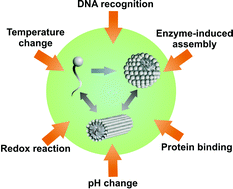Living systems are replete with complex, stimuli-responsive nanoscale materials and molecular self-assemblies. There is an ever increasing and intense interest within the chemical sciences to understand, mimic and interface with these biological systems utilizing synthetic and/or semi-synthetic tools. Our aim in this review is to give perspective on this emerging field of research by highlighting examples of polymeric nanoparticles and micelles that are prepared utilizing biopolymers together with synthetic polymers for the purpose of developing nanomaterials capable of interacting and responding to biologically relevant stimuli. It is expected that with the merging of evolved biological molecules with synthetic materials, will come the ability to prepare complex, functional devices. A variety of applications will become accessible including self-healing materials, self-replicating systems, biodiagnostic tools, drug targeting materials and autonomous, adaptive sensors. Most importantly, the success of this type of strategy will impact how biomolecules are stabilized and incorporated into synthetic devices and at the same time, will influence how synthetic materials are utilized within biomedical applications.

You have access to this article
 Please wait while we load your content...
Something went wrong. Try again?
Please wait while we load your content...
Something went wrong. Try again?


 Please wait while we load your content...
Please wait while we load your content...